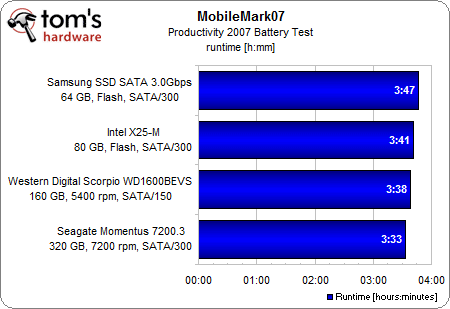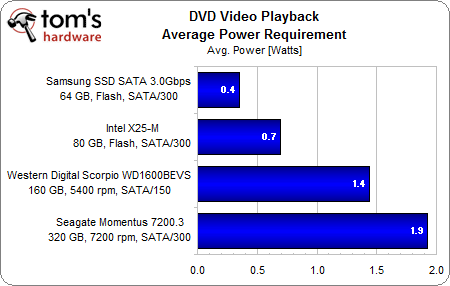Intel's X25-M Solid State Drive Reviewed
Mobilemark 2007, Low-Power Idle Power, DVD Playback
Finally, we want to look at the effective battery run time on the Dell Latitude D630 notebook. Since we ran some of the tests in parallel, we used two different machines. The following tests with Mobilemark were performed on a Latitude D630 using a Core 2 Duo T9300 (2.5 GHz). This is a device that Samsung Europe provides to reviewers, and we decided to select it for this comparison. It utilizes the 6-cell, 56 Wh battery. The other two tests, low power idle and DVD playback, were conducted on our Dell Latitude D630, which is basically the same notebook but utilizes a Core 2 Duo T9500 CPU (2.6 GHz).

Mobilemark is one of several tools that can be used to measure battery run time under controlled workloads. We found the difference to be marginal, since this is one of the most efficient business notebooks on the market, but the difference is still noticeable. The Samsung 64 GB SSD SATA-2 will give you the best battery run time and excellent application performance (see SYSmark 2007 results), while Intel is close behind, providing much better low-level performance but not quite the same low power level. The fastest hard drive, spinning at 7,200 RPM, caused the battery run time to be the shortest.

We measured low power idle on our 2.6 GHz Dell Latitude D630, as our storage test system isn’t a good choice for this type of test: modern SATA drives require a modern controller to be able to switch to low-power idle states. Intel manages to finish this test with a bang: 0.07 W idle power is negligible. Samsung still is very efficient, but the hard drives all require clearly more power.

Finally, we wanted to know the average power requirement when a defined stream of data is requested, so playing DVD video off the drives looked like a good option. Again, Samsung was most efficient, but Intel takes an excellent second position, as both conventional drives require at least double the power to provide this amount of data.
Get Tom's Hardware's best news and in-depth reviews, straight to your inbox.
Current page: Mobilemark 2007, Low-Power Idle Power, DVD Playback
Prev Page Performance per Watt: Streaming Reads Next Page Conclusion: X25-M Strikes Hard!